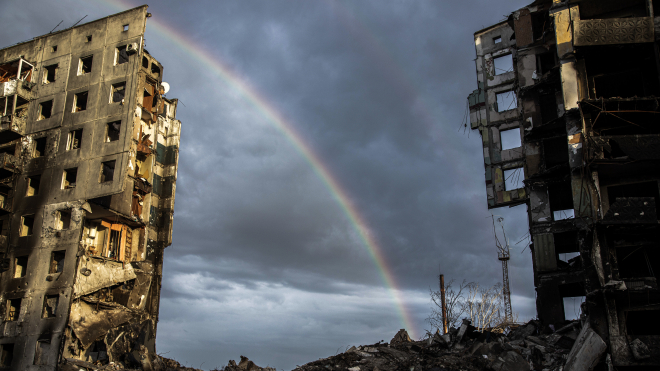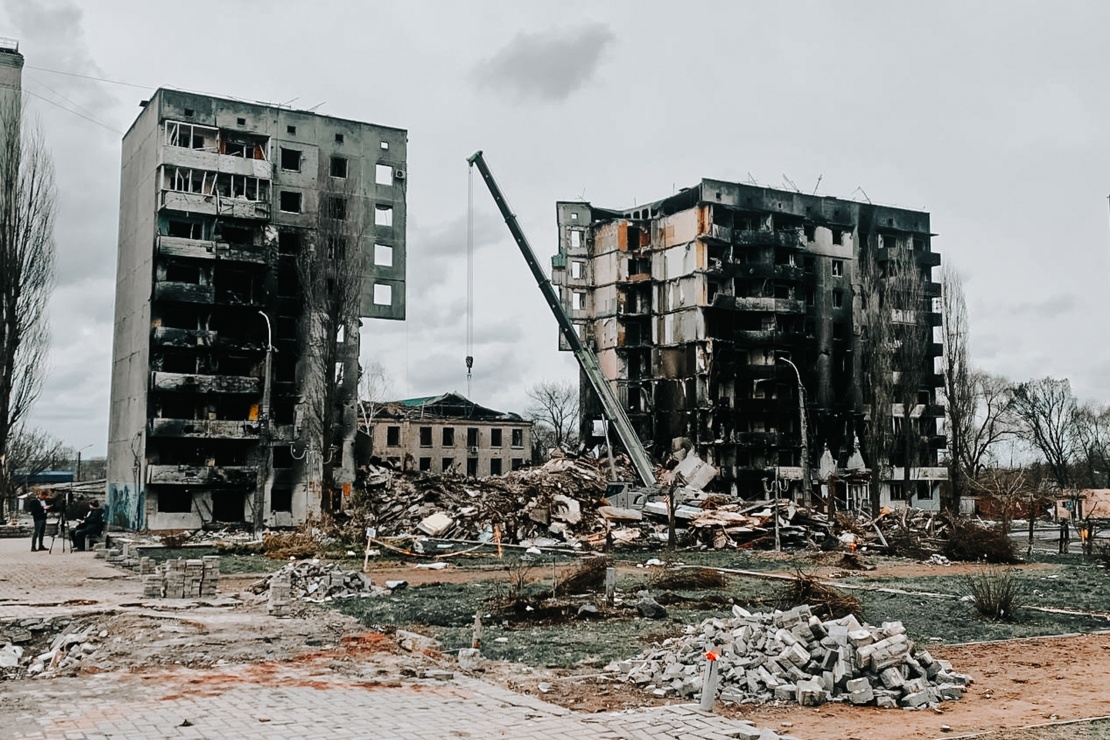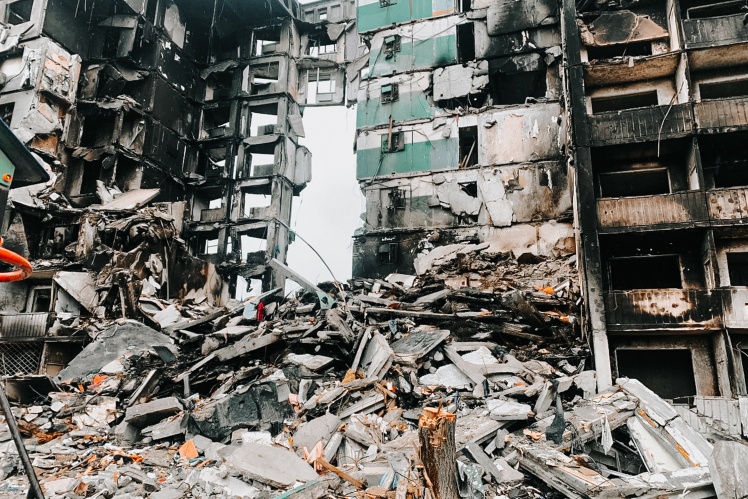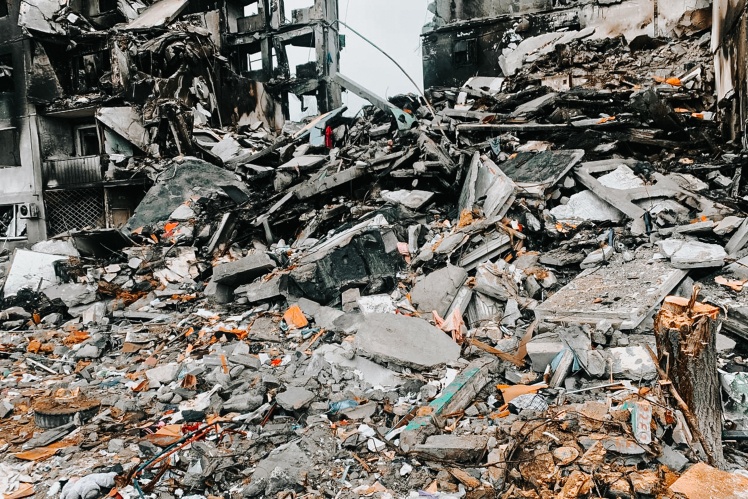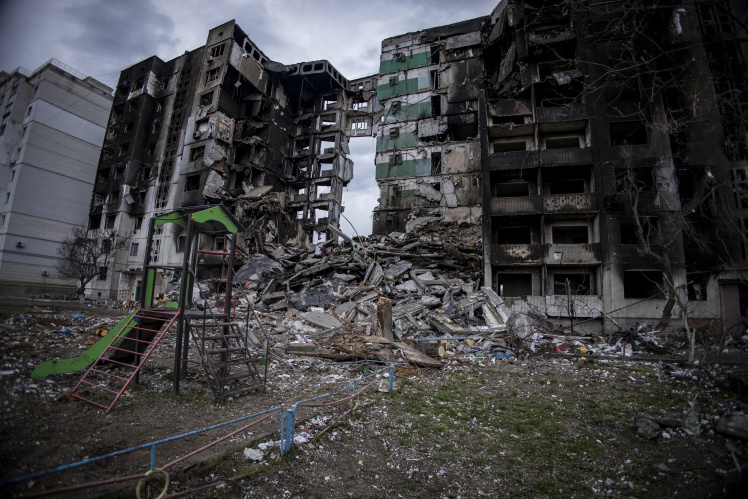Excavation of blockages
Pavlo Hachnikov is standing near the black ruins of the house №359 on Tsentralnaya Street. He is looking for Zinaida and Leonidʼs parents, who lived in this panel on the second floor and hid in the basement. After the air raid on March 2, fragments of side apartments remained from the house with three entrances and nine floors. In the middle, there is a mountain of concrete and iron mixed with furniture, clothing and people. The blockage reaches the third floor.
«Babel'»
It is April 5 on the calendar. There are no rescuers nearby.
- Why no one takes care of our house? We told everyone that they could be alive in the basement, we passed the plan of the basement to the rescuers, — says Gachnikov. — I was born here. I ran around the basement with the guys, and Iʼm good at it. The house is prefabricated and stands on stilts, and they are strong. When the Russians dropped the bombs, the first entrance did not collapse — about 12 people even came out of its basement. The second entrance collapsed along with half of the third. But the destruction is crumbly. There is a chance that the stilts are intact, and so are the people
The State Emergency Service, meanwhile, is dismantling high-bombed high-rise buildings at the entrance to the town. House №429 stood on the so-called "circle". Locals called it "At Sashaʼs" — after the name of the restaurant nearby. The Russians hit it and a nearby house on the morning of March 1. These were the first houses to be bombed. High-rise buildings partially collapsed and burned, but people in the basements survived.
"About 100 percent of the residents came out of the basement and the people helped them," says Pavlo. — So far no one has approached our house.
The sappers explain that the Russians could have mined the ruins, so it is impossible to dismantle the debris until everything is checked. Locals are running along the surviving first entrance. People save at least some property — take out bags of clothes, microwaves, kettles, chairs are lowered through the windows with a rope.
- Entrances to the basement can be mined, — we hear another argument why rescue work does not begin.
People respond: "We went down. They tried to move the stones. The body lies down there, it can be seen through the broken concrete slabs".
April 6. Climbers who came to help dismantle the debris say that House 359 is the most destroyed in Ukraine and, therefore, the most difficult to dismantle. There are not enough excavators and trucks in Borodianka to take out the piles of concrete. They are huge, and maximum capacity is required.
«Babel'»
- Kyiv Oblast is so badly damaged that no one and nothing reaches us, — complains Pavlo. — It was agreed that if we find equipment, rescuers will start work.
About a dozen men in the uniform of the State Emergency of Ukraine are sitting on benches near the ruins. The bomb destroyed the house but did not hit the bench. The men have disposable plates in their hands. Itʼs lunchtime. In the central square, near the shot bust of Taras Shevchenko, hot food is distributed. Rescuers say — some walls "hung" in the air, so it is likely that they will fall as soon as work begins below.
- What can you do? — I ask.
- Look for a crane or, alternatively, plant explosives on each floor. Calculate everything and knock down the slabs.
- What about those in the basement?
"Do you have anyone there?" — Rescuers ask cautiously. — We sympathize, but…
In the evening, Pavlo was called by Victoria Ruban, a spokeswoman for the State Emergency Service of Ukraine. She said that machinery was leaving for Borodianka, but it was unknown whether there was a crane. Later, Petro Kiselyov, acting head of the main department of the State Emergency Service in Kyiv Oblast, called. He asked if there really were people in the 359th in the basement. Pavlo confirmed.
- All day various officials, I wonʼt specify who exactly, call and say: "SES dismantles blockages". How do they disassemble? Iʼm standing here, they donʼt work at our house, — Pavlo recounts the conversations.
The rescue operation started on April 7. At the 36th day after the flight.
«Babel'»
- In the morning, a woman called. She refused to say her name, — says Pavlo. — She said she was from my classmate, and that she paid for the work of cranes, dump trucks, forklifts. Cars are going to Borodyanka.
Pavlo found his parents. Their bodies were on the steps of the porch. Not scorched and not torn by the blast wave. Next to a bag with documents.
- Their bodies are intact. In the literal sense, — he constantly repeats.
This will be important because after dismantling the debris, rescuers will see that the blast wave destroyed basements and walls. The first floor of the second entrance collapsed. People with stones were squeezed into the basement of the third entrance.
- If you ask how many people we find, I do not know how to answer. We find bodies and find the remains of bodies. Half skull, bone… Only chest and the person was identified by a passport in a breast pocket. Legs, arms, head. Man with a cat. They are burnt and without limbs. Do you understand what bomb they dropped on the house? — says Pavlo. — People were torn to pieces.
Four air raids
- There were four air raids on Borodianka. They bombed from March 1 to 3, — says the village head Hryhoriy Yerko. — Seven houses were destroyed by airstrikes. Two more collapsed because they were shot by tanks. All high-rise buildings stand on Tsentralna. The number of dropped bombs is being established. I think there are dozens.
Military equipment with the letter V appeared in Borodianka on February 25. It came from Ivankiv and moved to Makariv. The locals understood that if the invasion took place through Belarus and the Chornobyl nuclear power plant was captured; they would have occupation troops in the near future. But they hoped that the Russians would pass by without stopping.
- I live in Bila Tserkva. On the morning of February 24, I woke up at four in the morning from the noise — our aircraft was taking off into the sky. Then the Russians started bombing, — recalls Pavlo. — I gathered my children and wife, we went out of town. The parents said it is quiet here. Who would have thought that air bombs would be dropped on a 12,000 people village without a single military facility?
The Russians began to destroy Borodianka on the approach. They rushed in front of them from the tanks wherever they went. The first victims were residents of a private house on the outskirts. One shot and a family of six died under the rubble. Their two-year-old child was taken to the hospital in critical condition.
«Babel'»
The columns passed by Borodianka and partially remained in the town. People say that they had three groups: "Kadyrovites", servicemen of the 234th Assault Regiment from Pskov and 36 separate motorized infantry brigades of the Trans-Baikal region. The most brutal ones were the Pskovites, the Buryats looted the most, and the Kadyrovites kept away from them. "Grads" [multiple rocket launchers] and Russian tanks were placed in the yards. If any house was at their way, it was shot and rammed, they crushed everyone who hid in it.
On the evening of March 1, Ilona Tereshchuk texted her friend Oksana Hryhorska: “We were bombed. I donʼt even know whatʼs left: shops, schools, kindergarten, and private houses. My house was blown up. We ran to the shelter, [the shells] were whistling at our backs. Today it was hell."
Ilona lived in house №353. After they were fired upon, she and her husband and their 13-year-old son hid in a nearby cellar, of house №359. Other residents of the house came there at night.
- The bombs on the 359th were dropped in the morning between 7:40 and 8:00. People said that all the clocks stopped after the blast. I found a watch in the yard. The arrows show 7:40, — says Pavlo.
House № 353.
«Babel'»; Stas Kozlyuk / «Babel'»
Around the house and in the rubble, Paul collected pieces of sharp metal. A UK military expert who arrived in Borodianka said it was the wreckage of a Russian FAB-500 bomb.
- Or maybe, looking at the nature of the destruction, FAB-1000, — says Pavlo. — Our military said that in the area of the private sector, the Russians dropped the FAB-250. The nature of the destruction there is much smaller than in our town.
The survivors of the bombing saw a SU-25-like plane first circling the street. It flew perpendicular to the river Zdvizh. He made a U-turn, levelled along with the house №353 and fired. Then another plane appeared in the sky, dropping a bomb on the 359th from the side of the road, turning over the private sector and attacked the house from the yard for the second time.
Those who were in the side apartments and survived felt the first blast wave, the second, and after the third plaster fell, gas exploded, and the house fell in the middle.
- I would like to understand, whether that the second attack is a bomb of the same nature as the first or an incendiary missile. If the UK expert believes that the nature of the destruction as in FAB-1000, it is possible to drop bombs on both sides of the house for 500 kilograms, — says Pavlo.
- There was gas, water, and light in the house. You see, linen is hanging on the balcony on the ninth floor, Pavlo points up.
Wherever he points, the walls are black with burning, but inside the balcony, a blue T-shirt, light towels, and a striped sweater are developing in the wind. They were hung there to dry before the explosion. On the sidewall of the same entrance, there is an inscription: "All the best to the children."
«Babel'»
- The first days of the occupation, the house was shot with an armored personnel carrier and a tank. Above the parentsʼ apartment, on the third floor, they shot the apartment. The Russians fired on people in basements and then dropped aerial bombs on them, says Pavlo. — Eyewitnesses say that their professionalism was felt after the pilots struck. These were not the mistakes of some young men. They saw a lot of people coming in and out of the basements — they purposefully dropped bombs on them.
The ruins of all nine shattered Borodianka houses were dismantled by the second half of April. The State Emergency Service reported that no one was rescued, and 41 bodies were rescued from the rubble.
- The bodies of Ilona, Ihor and Oleksandr Tereshchuk were recognized by their eldest daughter Maria, — says Oksana Hryhorska. — Ilona and I have been friends since kindergarten and during our school years. We sat at the same desk, exchanged clothes, taught lessons together. She was an incredible, very kind and bright girl. Always smiling, sincere.
Everyone who was identified was buried in Borodianka cemetery until Easter.
Cemetery
At the funeral Sunday, May 1, the families of the victims gathered in Borodianka. There are more than thirty graves in the new section of the cemetery. Each of them has the same date of death: March 2, 2022. Among them are the graves of Pavlo Hachnikovʼs parents.
Sergei Gorbachev / Facebook
- Borodianka was their home, so I buried them here. My mother worked as a kindergarten chef for more than 30 years. Many people know her. All respond warmly. My father worked as a power engineer at the Red Excavator Plant. He was distinguished by his language — he is Belarusian. He came to work at the factory, and got an apartment, where he died.
People stood in the cemetery in silence — there was nothing left to do. ,Pavlo after Borodianka, still went to Bucha; there are also two fresh graves of his family.
- When our house was excavated, it was reported that in Bucha, Russians mocked, tortured and killed my uncle — my motherʼs brother Pavlo Vlasenko. After his death, his body was set on fire, — says the man. — The Russians also killed my nephew — grandfatherʼs grandson — twenty-year-old Dmytro Chaplyhin. He was tortured and repeatedly shot.
There is only a month and a year on Dmytroʼs grave — 03.2022.
"Only his killers know the day of Dmytroʼs death," Pavlo explains. — We only know that he was abducted a month before his uncleʼs murder.
- Was Dmytro in territorial defence? — I ask.
- No, he was a civilian guy. He worked at Epicenter. My uncle had very poor eyesight, was injured as a child and wore glasses. They had nothing to do with the military issue, and they didnʼt have anything like that at home, — says Pavlo, gaining more air in his lungs.
He pauses for a moment, then says:
- After all these horrors, I donʼt even know how I didnʼt go crazy.
Getty Images / «Babel'»
